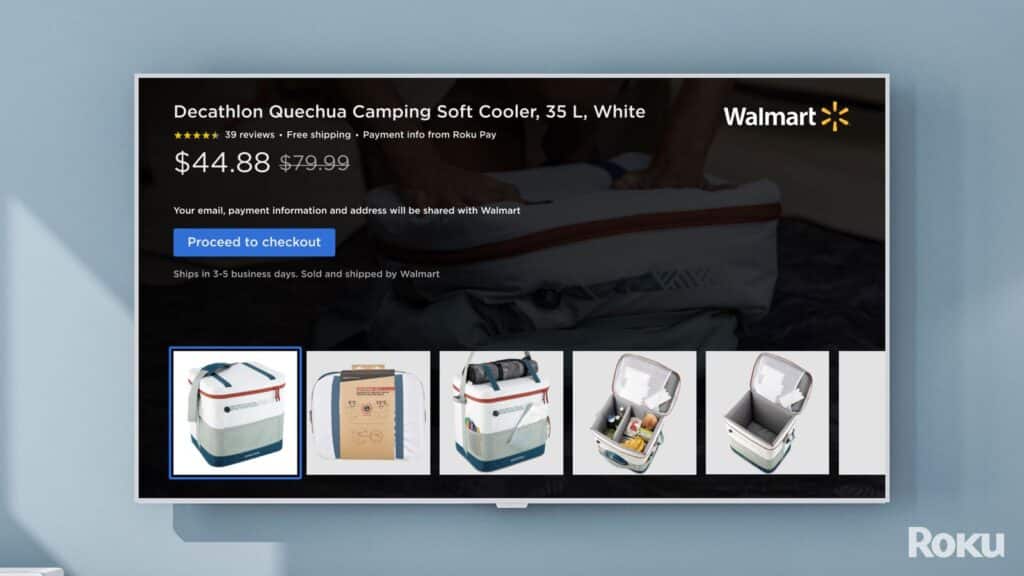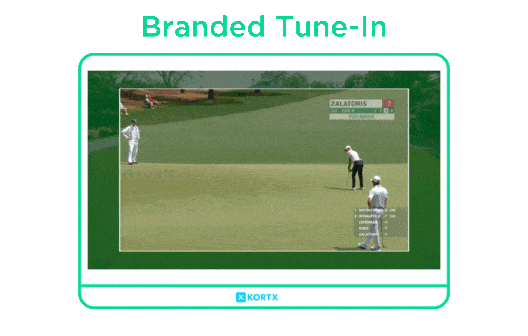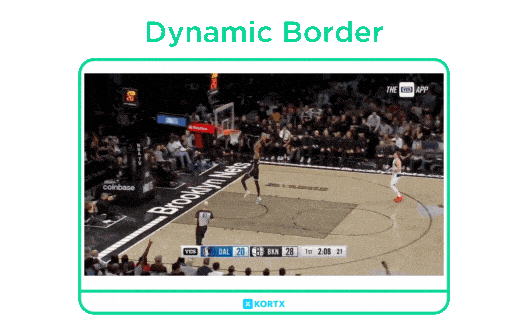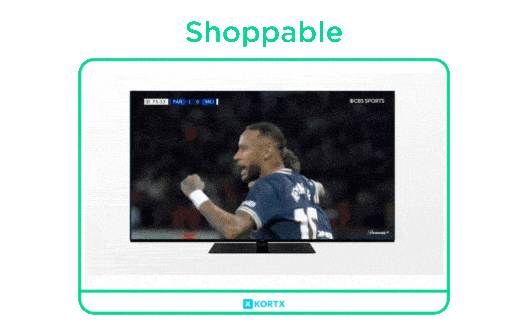Unlike linear TV, interactive CTV (interactive connected television) advertising delivers viewers a more engaging viewing experience.
Interactive CTV can take many forms, including interactive overlays, Picture-in-Picture (PiP), and carousel ads. Viewers directly interact with the ad, increasing engagement rates across the board.
Review what interactive CTV is, how it differs from interactive video, why it’s important, and examine the various types of interactive CTV you can use for your audience.
✨ In the last year, interactive CTV campaigns drove a 5.42% engagement rate, compared to a rate of 0.97% for mobile and PC.
What is Interactive CTV?
Interactive CTV is a type of CTV advertising that enables viewers to engage directly with video advertisements using advanced creative features like QR codes or other interactive capabilities.
Example: if a brand wants to market its Fourth of July sale, it could use a video advertisement with a QR code or other interactive element, allowing the audience to scan the screen and access the brand’s website or dedicated landing page with more information about the sale or even purchase directly from their CTV device.
Walmart partnered with Roku to make interactive CTV shopping seamless. Roku viewers served a Walmart ad can press “OK” to proceed to checkout and purchase an item.
This level of interactivity is made possible by the advanced technology used in CTV advertising, which enables advertisers to target specific audiences with personalized content and track viewer engagement with their ads.
What is the difference between CTV and interactive CTV?
CTV (Connected Television) enables viewers to stream TV content through an internet connection rather than through traditional cable or broadcast TV services (e.g., smart TVs, streaming media players, gaming consoles).
Interactive CTV enables viewers to interact with the content they watch using advanced technology and interactivity features like clickable links, quizzes, and QR codes directly accessible from the viewer’s screen.
In other words, interactive CTV is an enhanced version of CTV advertising.
How Is Interactive CTV Different from Interactive Video?
Though similar, interactive video isn’t to be confused with Interactive CTV.
Interactive video allows users to engage with video content through various interactive elements such as ad product scrolls, maps, form fills, and more on desktop, mobile, and tablet devices.
Interactive CTV is a type of video ad creative that specifically targets connected TV devices (e.g., smart TVs, gaming consoles) and allows viewers to engage with the ad through QR codes or other interactive capabilities within the connected TV inventory.
Can you use CTV and online video advertising together?
Although some video/ad formats can be used in interactive CTV and online video advertising, you must consider the user experience.For example, a customer could use a :15 video spot (QR code) for online video advertising, which can be extended to a :30 cut with a QR code element for CTV.If you ever struggle to distinguish between CTV and interactive video, think of the user experience.For this Chevy lead form ad, the user experience would not allow viewers to complete the form if they served the ad on their smart TV (CTV). However, they might have a chance to capture the form fill if it is served to someone on a desktop or tablet.”

Interactive CTV ads display as in-stream or in-break. In-stream or in-break ads are shown during a break in the main video content, such as during a commercial break in a TV show or movie.
Imagine you’re streaming your favorite show on a smart TV, and a 30-second ad for a new car model appears during the commercial break. This is an example of an in-stream or in-break ad, designed to reach a large audience during popular content.
What Are the Benefits of Interactive CTV?
Unlike linear TV, interactive CTV merges storytelling with interactivity to create a personalized, immersive, user-driven experience.
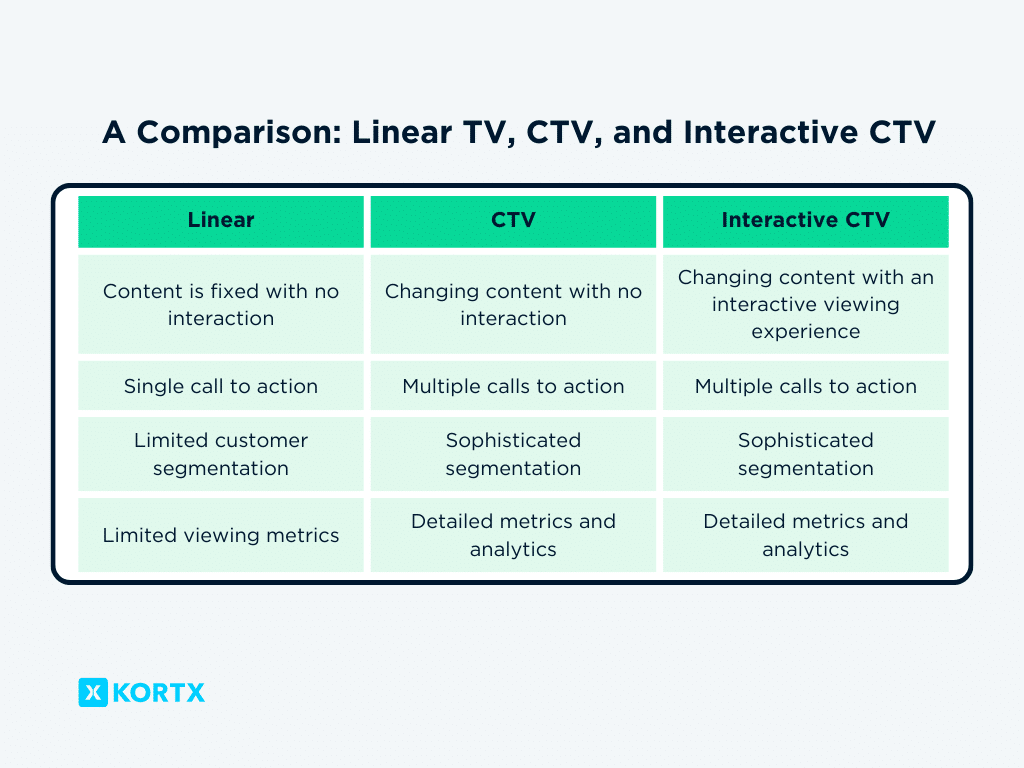
Among all types of interactive ads that users engage with daily, interactive video ads have the highest engagement rates, as 36% of respondents stated they interact with interactive video ads the most.
Interactive CTV ads have a host of other benefits including:
1. Greater Reach
Interactive CTV ads can target viewers across a wide range of CTV devices and platforms, including smart TVs, streaming devices, and gaming consoles, reaching a broader audience than traditional linear TV ads.
Ad spending reflects this shift in viewership habits. As spending on linear TV continues to decline YOY (from $65.66 billion in 2021 to $61.31 billion in 2023), connected TV is on the upswing (from $17.30 billion in 2021 to $25.09 billion in 2023).
Advertisers are betting on the continued growth and adoption of connected TV as a preferred viewing platform for audiences.
eMarketer found that 94% of US households (around 120.86 million households) were reachable through programmatic CTV advertising in 2022.
Meanwhile, eMarketer predicts that a mere 60.5 million households will watch linear TV but drop to 47.8 million by 2027.
These data underscore the growing importance of programmatic CTV advertising for those looking to reach the vast majority of American households.
⚡ With 21% of US adults ditching their cable TV for streaming services, marketers need new options to reach these viewers and stay competitive beyond traditional media.
2. Positive Brand Lift
According to Amazon’s Advertising Benchmarking Study, interactive video ad campaigns were +1.3x more likely on average to deliver a positive brand lift than video campaigns without interactive ads.
Amazon analyzed Third-Party brand lift metrics from 31 interactive video ad campaigns and 495 video campaigns without interactive ads revealing that interactive video ads outperformed traditional non-interactive video ads regarding ad recall, brand awareness, favorability, and purchase consideration.
Interactive video ads’ interactive elements like quizzes, polls, and games create a more enjoyable and memorable ad experience, leading to higher attention, recall, retention, affinity, and favorability towards the brand.
Take your ads from snooze to interactive views.
Transform passive advertising into engaging experiences that captivate viewers and drive brand recall, affinity, and purchase consideration.
3. Stronger Purchase Consideration
Interactive CTV ads can help drive stronger purchase intent and increase shopping actions.
Amazon’s Advertising Benchmarketing Study also found that interaction rates for the Show Now CTA on interactive video ads outperformed the detail page view rate for non-interactive video ads by +2.2x.
The study measured First-Party metrics from 277 campaigns to understand how interactive video ads performed in driving add-to-carts, purchases, and interactions with “send me more” information.
Interactive video ads have the supreme power to captivate viewers and drive purchase intent.
How do advertisers measure an OTT/CTV campaign’s success?
“The most common metric for OTT/CTV is Video Completion Rate (VCR), and the industry benchmark is 90%+, with some getting into the high 90s. If a campaign is structured with more sophisticated site tagging, onsite actions or conversions can be attributed to an OTT/CTV ad exposure. Since users can’t click on CTV ads, it will be measured as post-view attribution (e.g. they saw the CTV ad and then later went to the brand’s site).”

4. Increased Conversion Rates
By nature, linear videos encourage a passive viewing experience. Interactive CTV ads allow viewers to participate actively in the ad and become a part of the story.
Upland Software found that interactive content generates 2x more conversions than passive content. They also found that marketers who adopted interactive content strategies report that they generate conversions “moderately” or “very well” 70% of the time compared to just 36% for passive linear content.
5. Longer Engagement and Viewing Rates
According to a study from Magna, a media strategy group, interactive video ads drive a 47% gain in time spent with a marketing message compared to a non-interactive ad.
Mobile Marketer’s press release revealed that brands could increase their engagement time with consumers to triple the time spent with 15-second interactive ads if consumers interact with them.
Also, more insights from the Amazon Benchmarketing study found that 30-second interactive video ads outperformed 15-second ones, with 30-second ads delivering an average interactivity rate of +2.4x.
So, not only do interactive features increase the time viewers engage with marketing messages, but they can lead to even longer exposure times, giving brands more time to convey their message and showcase their products or services.
Interactive CTV Formats
Interactive CTV advertising offers numerous engaging ways to showcase brands and products alongside streaming content, and the optimal format will depend on the marketing campaign’s objectives.
Below are some examples that provide a glimpse into the possibilities of interactive CTV advertising placements.
#1 Picture-in-Picture
Picture-in-Picture (PiP) ads help create a memorable brand experience by aligning with sports, gaming, and entertainment events. PiP can optimize your campaigns with device and geography analyses, integrate your brand with live content across CTV inventory, and trigger campaigns at the best times using real-time data.
In this ad for the watch brand Tissot, a commercial plays alongside coverage of a bike race. The frame and half-screen ad video allow viewers to continue watching the game while gaining access to the commercial content.
Main use cases: Boost brand awareness, brand lift, and purchase consideration
📺 What is Picture-in-Picture (PiP) advertising?
Picture-in-Picture (PiP) advertising (or in-stream advertising) presents advertisements in a smaller, secondary window, as a border, or screen within the main content, making it less disruptive than traditional advertising.
Viewers watch live or on-demand content without moving to a commercial break, increasing the chances of a positive advertisement engagement experience.
#2 Picture-in-Picture (Tune-In)
Branded tune-in ads automatically allow your brand to place commercials during specific stream points. In this example, Rolex placed a commercial during a lull in a golf game, utilizing a branded frame.
Main use cases: Boost brand awareness, brand lift, and purchase consideration
What are the benefits of Picture-in-Picture (PiP) advertising?
- High Audio and Visible Complete Rates (AVOC): PiP ads have a high AVOC rate of 96% compared to the industry average of 39%, meaning a higher percentage of viewers view and hear the entire ad.
- Improved Ad Completion Rate: Users are more likely to view the entire ad than traditional commercials, leading to an ad completion rate of 95%.
- Increased Brand Recall: PiP ads significantly lift brand recall compared to traditional placements, with 94% of consumers recalling the brand.
- Boosted Recommendation Intent: PiP ads lead to an 8% lift in purchase intent (compared to traditional ads).
- Seamless Integration Leads to High-Impact Branding: Ads that run side-by-side with streaming content allow for a high-impact branding experience that does not interrupt the viewing experience.
Source: Nielsen & MOAT
#3 Border
Dynamic border PiP ads bring a branded border into the streamed content during critical moments. In this case, Dunkin Donuts designed a slam dunk-themed border for basketball games, allowing the brand to advertise and celebrate with fans.
Main use cases: Boost brand awareness, brand lift, and purchase consideration
#4 Shoppable
Brands focused on eCommerce sales can benefit from Shoppable PiP ads. In this example, the merch brand Fanatics utilized PiP ads showcasing a product and a QR code to promote their brand. Viewers then scanned the code with their smartphones to explore options.
Main use cases: App download, purchase
#5 Overlay
Overlays offer customizable content displayed over video assets to provide an easy-to-understand call to action.
Panera’s ad offers a “Start an order” CTA overlay so viewers can order food or drink directly from the ad.
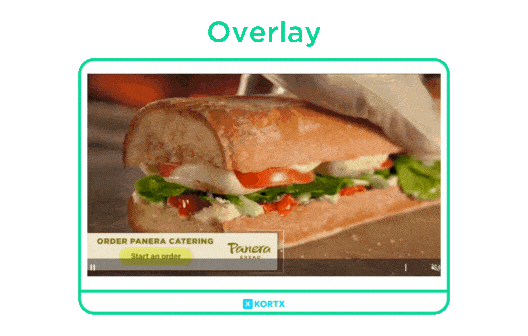
Main use cases: Boost brand awareness, brand lift, and purchase consideration
#6 Carousel
With CTV carousels, advertisers can showcase their best products or services while users engage with their video content, resulting in a more immersive and engaging ad experience.
In this ad, DJI, a drone manufacturer, showcases the amazing shots viewers can take with one of their drones. Enticed viewers can click the ad, leading them to the website to purchase a drone.
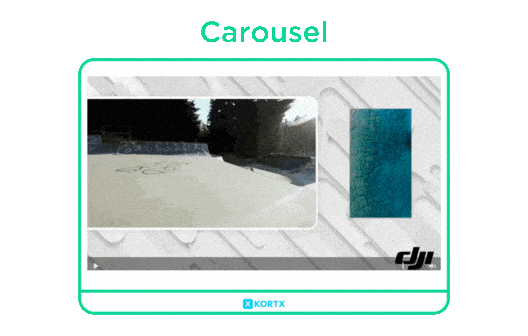
Main use cases: Boost brand awareness, brand lift, and purchase consideration
#7 Dynamic
Dynamic CTV ads deliver customized video content to specific audiences using real-time data. These ads allow marketers to deliver varied ad creative through a rule-based feed. This saves time and money by reusing existing assets and converting them into high-impact CTV ads.
Planet Fitness’s ad targets users at lunchtime and after work, using tailored ads and a QR code for its app.
Dynamic Ad #1: Lunchtime
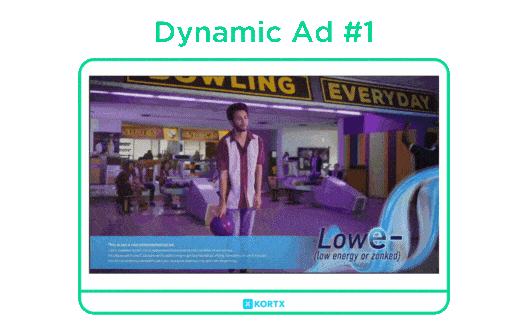
Dynamic Ad #2: Post-work
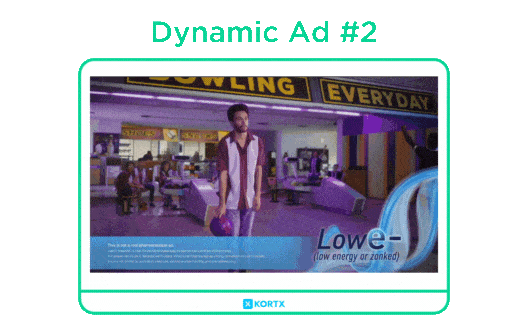
Expand your ads to desktop, mobile, or tablet with our Interactive Video offering! ▶️ ▶️
Choose from pre-, mid-, and post-roll and interactive video format options:
- Borders: Display your key messaging next to the video.
- Hotspots: Add an invisible overlay that initiates an action like pop-up windows.
- Shoppable: Promote app downloads and purchases alongside your video content.
- Leads: Capture intent and generate leads using custom forms directly in your video ads.
- Carousel: Showcase your best products or services while users engage with your video content.
- Overlay: Customize and display your content over your video assets for an easy-to-understand call-to-action.
Make your video ads stand out with our customizable options and repurpose them for any device.
An Interactive CTV Case Study
This case study shows how Flynn, an ad agency, and KORTX partnered to help Athlete Studio achieve a 99% video completion rate during the NFL season.
Targeting Goal
Athlete Studio wanted to capture fans’ attention and encourage purchases while minimizing disruption to their live sports viewing experience.
Strategic Approach
So, Flynn and KORTX came up with a game plan and helped Athlete Studio utilize Picture-in-Picture (PiP) CTV during the game, showcasing the latest merchandise from Eagles QB Jalen Hurts. This strategy allowed Athlete Studio to leverage over 7 hours of FOX and FOX Sports live coverage.

The results?

The case study demonstrates how interactive CTV advertising helped Athlete Studio significantly increase purchases and organic website traffic.
Offering a brand-safe way to showcase your services, products, and solutions, PIP, and in-stream advertising help tell customers about your brand without interrupting their live sports or event experience.
Interactive CTV & The Streaming Future
The shift from traditional linear TV to connected TV (CTV) has significantly changed how marketers reach their target audience.
Interactive CTV advertising has emerged as a popular option for marketing teams looking to showcase their brand interactively, offering a more engaging viewing experience than linear TV.
Using advanced creative features like QR codes or other interactive capabilities, interactive CTV allows viewers to engage directly with the video advertisements, leading to higher engagement rates than other advertising forms.
In a world where attention spans are shorter than ever, interactive CTV advertising may just be the key to capturing your audience’s eyes.
Ads Your Customers Want to Watch!
Combine data-driven targeting and inventive creative with KORTX’s interactive CTV advertising.
Eric Simone is the lead designer at KORTX. Not only is he a design wizard, but he’s also a pro at commercial editing, UX, and project management. Eric has made it his mission to deliver eye-catching designs that pack a punch.

